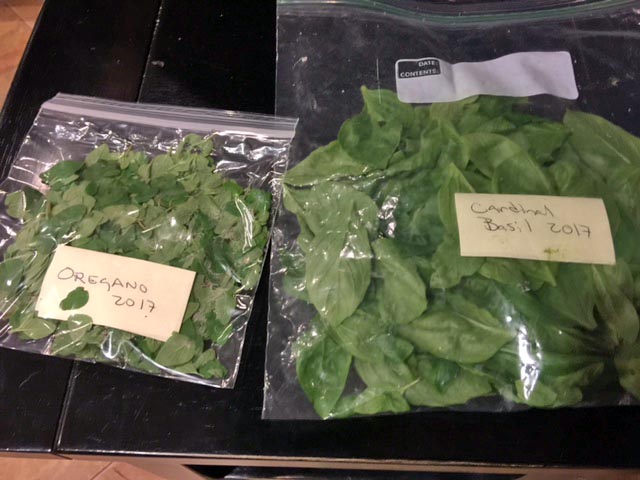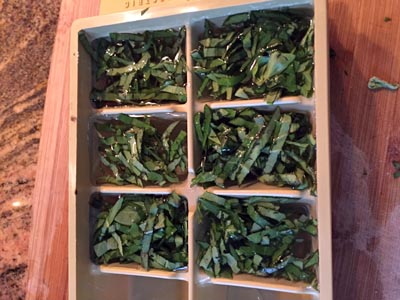Extending Your Harvest
By Molly O’Boyle, Fairfax Master Gardener
 When your garden gets just overwhelming, do you ever think about just letting the vegetables and leaves get eaten by critters, over-ripen until they are inedible, go to flower and seed, or start to decay on the vine? I have been there, too!
When your garden gets just overwhelming, do you ever think about just letting the vegetables and leaves get eaten by critters, over-ripen until they are inedible, go to flower and seed, or start to decay on the vine? I have been there, too!
Years ago, I decided to start canning my tomatoes because I had so many and did not have the freezer space for them. Since then, I have expanded the methods for extending my harvest so that my family and friends can enjoy them well into the next calendar year. You can do this, too, and it is not necessarily as difficult as you might think it is.
Canning
This truly is not as difficult as it sounds. You definitely need to have the equipment, which you can probably borrow from someone before you buy your own, and you need the confidence to get started. I read and read and re-read the instructions for water bath canning until I felt comfortable with it. NOW, everything is on the Internet, so you have lots of help and access to a lot more sources.
One thing people misunderstand about canning: you do NOT need to have 8 to 10 hours in one day to accomplish this task. You can do the prep and cooking in one day, and store it in the fridge. The next day, you can sterilize your jars and get the water ready, reheat what you are canning and finish the job. It is much easier this way, and you don’t feel you need to have an enormous block of time to accomplish the job.
You can use the water bath method of canning for anything that is acid enough — tomato soup/puree/chunks/ratatouille… You can preserve peaches, beets, beans, okra, or pickles as long as you have the right acidity to your brine/water mix.
Dehydration
If you have leafy herbs such as basil, sage, mint, thyme, oregano, tarragon and even rosemary, you can easily dehydrate these for easy storage for the next year. Two ways: tie up small batches of twigs with twine and suspend them from a string in a dry area, or place them in a dehydrator at 105 degrees for as long as it takes, usually 15+ hours. You can also do this in the microwave.
In addition, a dehydrator or a low temperature oven can be used for preservation of other produce. I have dehydrated cherry tomatoes, tomato slices, peaches, apples, figs, carrots and potatoes in an official dehydrator. What a treat these are!
Freezing
 If you have enough room, this is an exceptionally easy way to extend your harvest. With the ease of plastic bags, you can stack produce easily in the freezer. This can be done with herbs such as basil, oregano, thyme, chives, parsley and mint. Make sure to label them very well so that you know what you are looking for six months from now.
If you have enough room, this is an exceptionally easy way to extend your harvest. With the ease of plastic bags, you can stack produce easily in the freezer. This can be done with herbs such as basil, oregano, thyme, chives, parsley and mint. Make sure to label them very well so that you know what you are looking for six months from now.
You can freeze a quart- or gallon-sized bag of tomatoes, with or without the skin on. You can freeze parboiled beans, asparagus, shredded zucchini/squash, berries and chunks of parboiled potatoes, carrots, parsnips, turnips and radishes. If you want to freeze greens, you can blanch them very quickly in hot water (just a few seconds), dry and freeze. You can also blend the leaves with water, pour into ice cube trays and freeze for smoothies or soup recipes. While not the “most attractive” item in your freezer, they will come in very handy later when there are no longer farmers markets with kale, collards or turnip greens.

ice cube trays of herbs
Fermenting
This is a new one for me. I have gotten started with sauerkraut, which is really quite easy. You can ferment just about anything you want to do. Once it has reached the right taste for you, simply put the jars into the refrigerator. It is wise to NOT preserve this in a hot water bath, due to losing the vital benefits of the fermentation process. You also will need enough fridge space to handle this type of experimentation.
Pickling
What a fun way to extend your harvest! You can pickle so much more than cucumbers these days. Try carrots, peppers, onions, beets, green beans, ginger and garlic.
Don’t be afraid to create Refrigerator Pickles — you do not have to preserve these in a hot water bath. You can do small batches by cutting the brine in half. They will not last outside of the fridge, but you will have fresh, crunchy vegetables to enjoy in just a day or two. This produce will enliven a sandwich, a roast, an omelet or a salad so easily, and it takes no time at all to look up recipes to try online.
So, once you are done with your fresh, raw produce and want to try something to extend your harvest through the winter and spring, give these tactics a try. You will be so glad you did.
… updated 2024
-
Resources
- Pressure Canning, Virginia Cooperative Extension
- Basics of Home Canning, Penn State Extension
- Home Canning Basics, University of Minnesota Extension